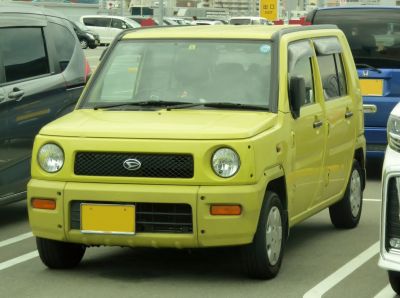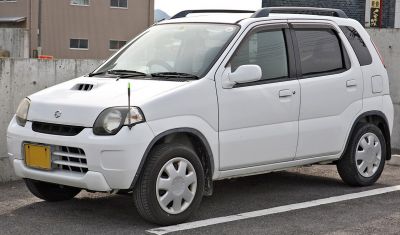 2001 Daihatsu Max Dimensions, Size & Specs
2001 Daihatsu Max Dimensions, Size & SpecsMeasurements of the 2001 Daihatsu Max, engineered for optimal performance and comfort
| Dimensions | |
|---|---|
| Length: | 3395 mm133.7 in11.1 ft |
| Width: | 1475 mm58.1 in4.8 ft |
| Height: | 1550 mm61.0 in5.1 ft |
| Weight Specifications | |
| Curb Weight: | 870 kg1918 lbs |
| Maximal permitted Weight: | 1090 kg2403 lbs |
| Tire Specifications | |
| Tire Size: |
|
The Daihatsu MAX (2001-2003) is a compact hatchback designed within the kei car segment primarily for the Japanese domestic market. This generation MAX offers practical urban mobility with its small footprint and efficient use of space. The vehicle measures 3395 mm (133.7 inches) in length, which makes it exceptionally maneuverable in tight city environments. Its width stands at 1475 mm (58.1 inches), while a relatively tall height of 1550 mm (61.0 inches) enhances headroom and interior spaciousness despite the small footprint. Weighing 870 kg (1,918 lbs) at curb weight and supporting a maximum weight of 1090 kg (2,403 lbs), the MAX balances lightweight agility with sufficient robustness for daily driving. The tires sized at 165/55 R14 contribute to a smooth and nimble driving experience. Overall, the Daihatsu MAX from 2001 to 2003 is a perfect example of a practical, small kei hatchback designed to optimize urban driving with compact dimensions, lightweight construction, and space-efficient design.
Discover the standout features that make the 2001 Daihatsu Max a leader in its class
Have a question? Please check our knowledgebase first.
The Daihatsu MAX from the 2001-2003 generation features compact exterior dimensions ideal for urban driving and tight parking environments. It measures 3395 mm (133.7 inches) in length, 1475 mm (58.1 inches) in width, and 1550 mm (61.0 inches) in height. These dimensions place the MAX firmly in the kei car segment, making it very maneuverable and easy to fit into smaller parking spaces. The compact size helps in city traffic and makes it economical without sacrificing too much passenger space.
With a width of 1475 mm (58.1 inches), the Daihatsu MAX offers a narrow body typical of kei cars, optimizing it for urban use where road and parking space can be limited. While this compact width restricts shoulder room compared to larger vehicles, it significantly improves parking convenience, allowing the MAX to fit into tight spots many wider cars can't. The narrower stance also contributes to easier maneuverability, making driving in congested city streets simpler.
The 2001-2003 Daihatsu MAX stands 1550 mm (61.0 inches) tall. This relatively tall height for a small hatchback benefits interior headroom, providing passengers with a roomy, comfortable cabin despite the car’s compact footprint. The increased vertical space enhances the feeling of openness inside the car, which is advantageous in a vehicle designed for city commuting. However, the taller height also means the vehicle has a higher profile, which can have a slight effect on aerodynamic performance at higher speeds, but this is a common compromise in kei cars for comfort.
The Daihatsu MAX has a curb weight of approximately 870 kg (1,918 lbs). This lightweight design is instrumental in promoting good fuel efficiency, as less mass requires less energy to move. Additionally, the lighter weight enhances handling agility, allowing the car to respond quickly to driver inputs and making it well-suited to city driving and quick maneuvers. The low weight also contributes to easier braking and improved overall vehicle dynamics, crucial for an urban commuter car.
The maximum weight or gross vehicle weight rating (GVWR) for the Daihatsu MAX is 1090 kg (2403 lbs). This figure includes the car's curb weight plus passengers, cargo, and any additional load. Considering its curb weight is 870 kg, the car can carry roughly 220 kg (485 lbs) of payload. This capacity is sufficient for four average adults and some luggage but is best suited for typical urban usage rather than heavy cargo transport.
Yes, the Daihatsu MAX can comfortably fit into a standard residential garage. With a length of 3395 mm (133.7 inches) and width of only 1475 mm (58.1 inches), it is smaller than most typical cars. Standard single-car garage dimensions are usually around 6 meters (236 inches) in length and 3 meters (118 inches) in width, which leaves plenty of space around the MAX for opening doors and moving around the vehicle. This compact size makes parking stress-free in tighter home garages.
The 2001-2003 Daihatsu MAX was introduced as a fresh model rather than a significant evolutionary step from a predecessor MAX generation, making direct comparisons limited. However, it continues the kei car tradition of compact exterior dimensions with efficient space utilization. Compared to earlier kei cars from Daihatsu before the MAX’s launch, this generation typically provides more refined packaging and slightly improved interior space and comfort without increasing the overall footprint much. It adheres closely to Japan's kei car size limits, balancing compactness and usability.
The Daihatsu MAX competes well within the kei car segment, matching closely with popular rivals like the Suzuki Alto and Mitsubishi eK Wagon. Its length of 3395 mm (133.7 inches), width of 1475 mm (58.1 inches), and height of 1550 mm (61.0 inches) place it squarely in the typical kei car size range. The MAX’s taller body design increases headroom, which can be an advantage over some competitors with lower rooflines. Overall, its compact size and light weight combine to make it incredibly practical for city driving, parking, and fuel economy, all key attributes buyers seek in this category.
The Daihatsu MAX (2001-2003) is equipped with 165/55 R14 tires. The relatively narrow width (165 mm) and low profile (aspect ratio 55) paired with 14-inch rims provide a balance between comfort and handling. The tire size supports nimble urban driving and responsive steering feel, contributing to the MAX’s agility on city streets. Smaller diameter wheels reduce unsprung weight, aiding ride comfort over bumpy surfaces while maintaining sufficient grip for everyday driving conditions.
Despite its compact exterior, the Daihatsu MAX is designed to maximize interior volume for passenger comfort. Thanks to its tall height of 1550 mm (61.0 inches), occupants benefit from ample headroom, which is excellent for adult passengers even in the rear seats. The cabin layout is straightforward with optimized space for four passengers, common in kei cars. While legroom and shoulder space are limited by the car's narrow 1475 mm (58.1 inches) width, the design focuses on ergonomic seating and practical storage compartments to make daily commuting comfortable and convenient.
Discover similar sized cars.

| Production: | 2002-2004 |
|---|---|
| Model Year: | 2000 |
| Length: | 3395 mm133.7 in |
| Width: | 1475 mm58.1 in |
| Height: | 1550 mm61.0 in |

| Production: | 1998-2006 |
|---|---|
| Model Year: | 1999 |
| Length: | 3355-3395 mm132.1-133.7 in |
| Width: | 1475 mm58.1 in |
| Height: | 1530-1550 mm60.2-61.0 in |

| Production: | 2020-present |
|---|---|
| Model Year: | 2020 |
| Length: | 3395 mm133.7 in |
| Width: | 1475 mm58.1 in |
| Height: | 1545-1570 mm60.8-61.8 in |

| Production: | 1998-2009 |
|---|---|
| Model Year: | 1999 |
| Length: | 3395 mm133.7 in |
| Width: | 1475 mm58.1 in |
| Height: | 1530-1545 mm60.2-60.8 in |
